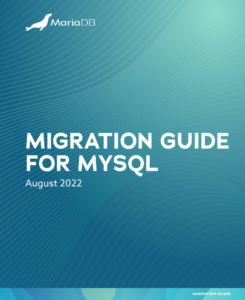The difference between choice and vendor lock-in
MySQL and MariaDB are both open source relational databases with comparable structure and functionality. But because Oracle owns MySQL, many users find themselves on a fast track to vendor-lock in with other proprietary solutions, such as Oracle Cloud and Oracle Heatwave. By contrast, MariaDB prioritizes flexibility and freedom for users. Our open source relational database started as a fork of MySQL and maintains protocol compatibility with MySQL. Our database experts – including the original core MySQL team – bring the best of database technology without vendor lock-in.
Jump ship before MySQL requires more product lock-in
After MySQL 5.7 reached End of Life in October 2023, many businesses realized that 8.0 pushed more Oracle lock-in and offered far less third-party compatibility than its predecessors. Organizations that want to avoid vendor lock-in need to think through alternate options. Luckily, jumping the MySQL ship doesn’t have to be complicated. MariaDB is a natural choice as it maintains compatibility with MySQL protocols, doesn’t require any changes to your application and doesn’t require your teams to learn new skills – making migration a breeze. Our open source database isn’t a pathway to vendor lock-in; it’s flexible, cloud native and can be deployed anywhere – private, public and hybrid cloud.
FAQs
1. Is MySQL 5.7 still supported?
MySQL 5.7 became EOL in October 2023. As such, users need to decide if they want to stay with MySQL 8.0 and progress to Oracle products such as Oracle Cloud and Oracle Heatwave. Alternatively, businesses can consider switching to a different open source database that offers more flexibility.
2. How do you downgrade MySQL 8 to 5.7?
Users cannot downgrade from MySQL 8 to 5.7. If users aren’t satisfied with MySQL 8, they must switch to another open source database.
3. How do I migrate from MySQL to MariaDB?
MariaDB started as a MySQL fork and uses the same wire protocol and SQL dialect, making the migration from MySQL to MariaDB relatively straightforward. MariaDB’s team of data experts offers an easy guide to migration for businesses to follow.
Migration Guide for MySQL
Understand the similarities and differences, both small and large, between MariaDB and MySQL – from common features such as standard SQL to unique capabilities such as multi-master replication, transaction replay, temporal tables and Oracle database compatibility. While there are clear advantages for both, review your projects on a case-by-case basis to determine which is right for you.
Read NowHow MariaDB carries the torch of open source database innovation
We have deep respect for our MySQL heritage and continue to maintain as much compatibility as possible, including protocol compatibility. However, we don’t let the past determine our future. The MariaDB team is constantly adding new features and capabilities that diverge from Oracle’s MySQL. Our next-generation database continues to carry innovation forward, with tens of millions of users worldwide.
Faster innovation.
MariaDB has a vibrant, active open source community with GNU and GPL licensing. We also publish quarterly GA releases of our community edition.
Default in Linux distributions.
MariaDB Server has replaced MySQL as the default in major Linux distributions including Debian, RHEL, CentOS, openSUSE and Fedora.
The M in LAMP.
MariaDB Server performs many of the same functions as MySQL while constantly innovating on new features. As a result, our database solution is commonly recognized as the “M” in the LAMP stack.
Pluggable storage engines.
Unlike MySQL, MariaDB Server leans in on its extensible architecture, supporting multiple purpose-built storage engines, enabling users to optimize for different workloads and use cases.
Billion+ downloads.
MariaDB Server has been downloaded over one billion times, attesting to our database’s ease of use, adaptability and resilience.
6 ways to do more with MariaDB
MariaDB and MySQL are both general-purpose databases. However, only MariaDB adheres to the open source mission while providing a consistent set of advanced features and functionality. MariaDB can deploy anywhere: on-prem or in any private, public or hybrid cloud. Our flexibility and compatibility mean a quick, easy startup for you and your team.
Oracle Database compatibility
MariaDB is the only open source database compatible with Oracle Database data types, sequences, PL/SQL stored procedures and more, making it possible to “lift and shift” without having to modify database schemas and rewrite store procedures.
High availability and scalability
Maintain continuous availability and hide failures from applications using zero-interruption failover features such as transaction replay. Vertical scale-out through parallel query, read replication and multi-master clustering.
Columnar storage format
MariaDB supports both row and columnar storage. It can be deployed as a data warehouse for interactive, ad hoc analytics or as a hybrid transactional/analytical processing, storing current data in row storage and historical data in columnar.
Federation
MariaDB and MySQL can access tables in other MariaDB/MySQL databases, but only MariaDB can federate heterogeneous databases, including Oracle Database, Microsoft SQL Server and IBM Db2, to consolidate data access and/or simplify database migration.
Temporal tables
MariaDB is the only open source database to implement system-versioned, application-time period and bitemporal tables, granting developers the ability to query data based on a previous point in time and DBAs to audit and/or recover data after it was changed.
JSON functionality
MariaDB goes beyond the bounds of a typical relational database with its ability to handle JavaScript Object Notation (JSON)-formatted data. This compatibility enables users to combine structured and semi-structured data.
MariaDB vs. MySQL
| MySQL | MariaDB | |
|---|---|---|
| MongoDB-compatible API | No | Yes |
| Columnar storage | No | Yes |
| Temporal tables | No | Yes |
| Oracle database compatibility | No | Yes |
| Non-blocking backups | No | Yes |
| Write-anywhere clustering | Yes | Yes |
| Transaction replay | No | Yes |
| Secure by default | Yes | Yes |





